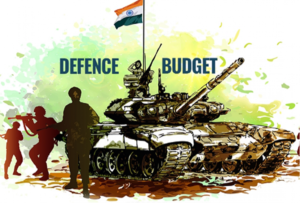Defence Budget 2023-24 : Preliminary Review
![]()

Given the multitude of threats that the country faces, the expectations of the Defence Forces were very high from the Finance Minister when she was presenting the Union Budget of 2023-24. Its land border with China and Pakistan extends over 6798 Km and maritime border is over 7000 km. In addition, it has the Island territories of Andaman & Nicobar and Lakshadweep to defend. While the Pakistani and Chinese threat along the land borders remains ever alive, with the presence of the Chinese Ships in Djibouti and Gwadar port even the maritime threat is in the realms of reality. When we superimpose the internal security threat in J&K, NE and the Red Corridor, the Indian Security Situation demands a strong hard power capability. These threats need a minimum of 3% of GDP allocation for defence. However, there are equally competing sectors such as health, water & food security, education, housing, green energy, infrastructure development that has traditionally restricted every finance minister of the country in meeting the full demands of the defence forces. The story was no different this year too. The 2023-24 defence budget follows the trend of the last few years with an increase of 12.5% in the overall outlay and is pegged at Rs. 5.94 lakh crore. The Capital outlay is Rs. 1.62 lakh Crore for purchase of new weapons, aircraft, warships, and other military hardware, which is an increase of around 9% from last year’s Capital expenditure of Rs. 1.52 lakh Crore. The allocation for Revenue expenditure is Rs. 2.70 lakh Crore as compared to 2.39 lakh Crore last year. A separate allocation of Rs. 1.38 lakh crore has been made for defence pensions taking the total Revenue Expenditure to Rs. 4.22 lakh Crores. The table below indicates the trend of defence budget of the last few years.
| Year | Total Allocation in Rs | % GDP | % of Total Budget |
| 2018-19 | 4,04,365 | 2.2 | 16.6 |
| 2019-20 | 4,31,011 | 2.0 | 15.47 |
| 2020-21 | 4,71,378 | 2.1 | 15.5 |
| 2021-22 | 4,78,196 | 2.4 | 13.73 |
| 2022-23 | 5,25,166 | 2.0 | 13.3 |
Reducing dependence on import of defence equipment to modernise the defence forces in quicker time frame to meet the Security Challenges especially those posed by China is a major challenge before the Ministry of Defence and the Armed Forces. Further, our overdependence on the Russian Equipment though has come down, still hovers at around 60%. We need to diversify to other countries for our short-term requirements till we achieve self-reliance. While the Government has given a push to indigenisation in the defence sector too through its Atmanirbhar Bharat initiative, it is a long-drawn process and will take some time. While exports in defence sector increased to Rs 12,815 in 2021-22, nearly eight times from Rs 1,521 crore in 2016-17, these figures pale in front of our imports which stand at USD 15,356 million dollars in the period 2017 – 2021 almost double that of China. India is the largest importer of defence equipment with almost 17% of the global import market. India needs to push through fast track to reduce its import dependence. It must only carryout essential high-tech imports that would boost its defence capability to deter any misadventure by China in the near future, reduce the flab in the defence forces to allocate larger portion of the defence budget for capital expenditure and modernisation. Towards this end the Agniveer Scheme though criticised by many, if implemented after taking care of the shortcomings would prove quite beneficial. To sum up the budget follows the trend and we cannot expect miracles from it unless we optimise our defence spending, diversify our exports from Russia, focus on indigenisation and promote our defence exports through greater participation by the private sector especially in high tech areas of robotics, unarmed aerial vehicles, artificial intelligence, communications, cyber and space capabilities.





